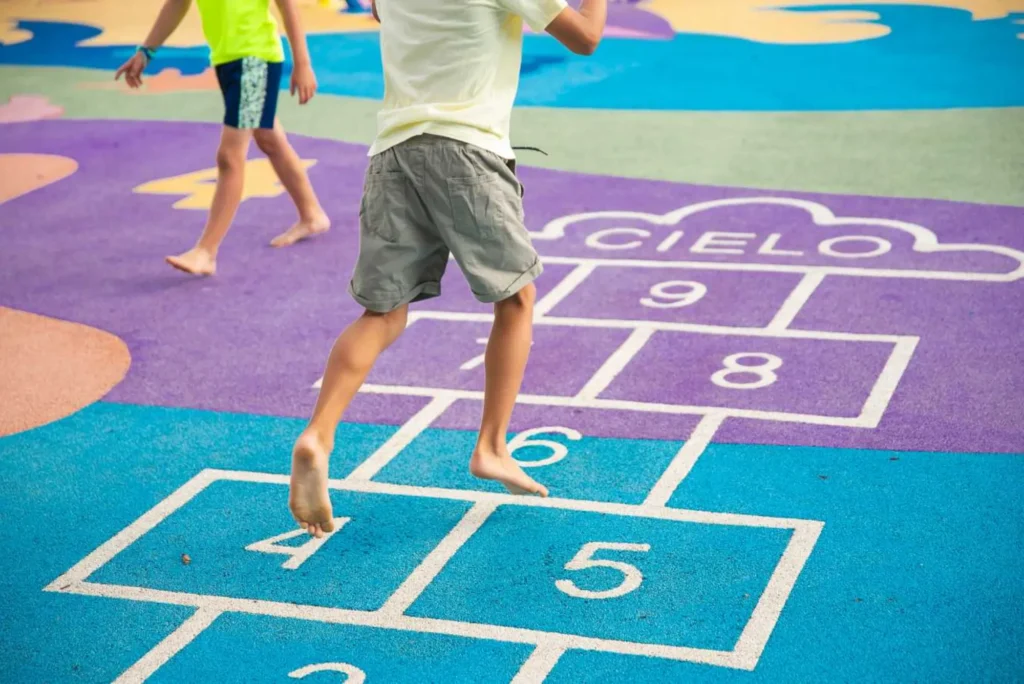Hopscotch is a classic playground game that has been enjoyed by children around the world for generations. Its origins can be traced back to ancient times, and it has evolved into a beloved pastime with various cultural significances. Hopscotch is one of many traditional kar games that have stood the test of time, offering fun and exercise in a simple, accessible format.
Equipment and Setup
Materials Needed
To play hopscotch, you will need the following materials:
- Chalk or tape: Used to draw the hopscotch grid on the ground. Chalk is ideal for outdoor play on concrete surfaces, while tape works well indoors.
- A marker: This can be a small stone, coin, or any small object that can be easily tossed and retrieved without rolling or bouncing too much.
Preparing the Playing Area
Selecting the right location is crucial for a smooth game of hopscotch. Look for a flat, hard surface like a sidewalk, driveway, or indoor floor space. Once you have chosen your spot, use the chalk or tape to draw the hopscotch grid. The grid typically consists of a series of numbered squares arranged in a linear pattern, often with single squares alternating with pairs of side-by-side squares.
Basic Rules of Hopscotch
The hopscotch game is a classic playground activity that is simple to learn but offers endless fun and physical exercise. The fundamental rules are straightforward, making it accessible to players of all ages. Here’s a detailed look at the basic rules of the hopscotch game:
Overview of the Game’s Objective
The primary objective of the hopscotch game is to complete a series of numbered squares by hopping on one foot, retrieving a marker, and returning to the start without stepping on the lines or losing balance. Each player aims to progress through the numbered squares, completing the entire grid.
Detailed Steps to Play

Decide the order in which players will take their turns. This can be done by age, a quick game of chance, or mutual agreement.
Tossing the Marker
The first player begins by tossing their marker (a small stone, coin, or another small object) into the first square (numbered 1) of the grid. The marker must land completely within the square without touching the borders or bouncing out. If it does not land correctly, the player loses their turn, and the next player proceeds.
Hopping Through the Grid
The player then hops through the grid on one foot, skipping the square with the marker. Single squares are hopped on one foot, while pairs of squares can be straddled with both feet (one foot in each square). The player must maintain their balance and avoid stepping on the lines.
Retrieving the Marker
Upon reaching the end of the grid, the player turns around and hops back towards the start. When they reach the square before the marker, they must balance on one foot and bend down to pick up the marker. The player then completes the grid by hopping back to the starting point.
Completing a Turn
If the player successfully retrieves the marker and returns to the start without stepping on the lines or losing balance, they move on to the next numbered square on their next turn. If they fail at any point (e.g., stepping on a line, losing balance, or incorrectly tossing the marker), their turn ends, and the next player takes their turn. The first player resumes their progress from the square where they left off on their next turn.
Example of a Turn in Hopscotch
- Player 1 tosses their marker into square 1.
- They hop over square 1 and continue hopping through the grid to the end.
- Turning around, they hop back, pause before square 1, retrieve the marker while balancing on one foot, and then hop back to the start.
- Player 1 successfully completes the turn and moves on to tossing the marker into square 2 on their next turn.
- If Player 1 had stepped on a line or lost balance, their turn would end, and Player 2 would begin their turn.
Winning the Game
The hopscotch game continues until a player successfully completes the entire grid by tossing the marker into each square sequentially and hopping through the grid without faults. The first player to complete the entire grid is declared the winner.
Common Faults in Hopscotch
Marker Landing Incorrectly: If the marker does not land within the correct square or touches the line, the player loses their turn.
Stepping on Lines: Players must avoid stepping on the lines of the grid. Doing so results in a fault and ends the player’s turn.
Losing Balance: Players must maintain their balance while hopping and picking up the marker. Falling or using hands to balance results in a fault.
Incorrect Hopping Pattern: Players must follow the correct hopping pattern, using one foot for single squares and both feet for pairs of squares. Deviating from this pattern is considered a fault.
Variations of Hopscotch
The hopscotch game, with its rich history and global appeal, has numerous variations that reflect regional cultures and traditions. Each variation brings a unique twist to the basic format, making the hopscotch game an exciting and adaptable activity. Let’s explore some of the most popular variations and how they incorporate different elements to enhance the classic hopscotch game.
Traditional Hopscotch vs. Regional Variations
While the traditional hopscotch game features a straightforward grid of numbered squares, many cultures have adapted the game to include unique rules and patterns. These regional variations often reflect local customs and the influence of other traditional games, known as kar games.
England – Hop-Scotch: In England, the hopscotch game often includes more elaborate grid designs, sometimes extending to ten or more squares. Players might encounter different hopping sequences or additional rules, such as hopping backward.
India – Stapu or Kith-Kith: The hopscotch game in India, known as Stapu or Kith-Kith, frequently involves a different grid layout, with squares arranged in a more intricate pattern. Players may also use unique markers and incorporate specific rituals or chants during the game.
France – Marelle: The French variation of the hopscotch game, called Marelle, includes different hopping patterns and sometimes incorporates elements from other traditional French games. The grid might be circular or spiral, adding a new level of challenge to the game.
Playing with Different Grid Designs
Experimenting with grid designs is a great way to keep the hopscotch game interesting. Here are a few examples of alternative grids you can try:
Circular Grids: Instead of the standard linear pattern, draw the squares in a circular arrangement. This design requires players to navigate the grid in a roundabout way, adding complexity to the game.
Spiral Grids: A spiral grid challenges players to follow a winding path, making balance and coordination even more critical.
Extended Paths: Create a longer grid with additional squares, requiring more hops to complete. This variation can test endurance and precision in the hopscotch game.
Introducing Additional Rules or Challenges
To make the hopscotch game more challenging and engaging, consider introducing extra rules or challenges:
Hopping Backward: Players must hop backward through the grid, increasing the difficulty and testing their spatial awareness.
Using Specific Feet: Require players to use only their left or right foot for certain sections of the grid, which enhances balance and coordination skills.
Penalty Squares: Add squares where players must perform a task if they land on them, such as clapping their hands or hopping in place. These penalty squares add an element of surprise and fun to the hopscotch game.
Popular Variations Around the World
In addition to the regional variations mentioned earlier, the hopscotch game has many other forms worldwide. Here are a few more examples:
China – Tian Guan: In this Chinese version, the hopscotch game involves a more complex grid, and players may need to perform specific actions, like bowing or saluting, at certain points.
Australia – Escargot: Also known as snail hopscotch, this variation features a spiral grid that resembles a snail’s shell. Players hop to the center and back, navigating the tight turns carefully.
South Africa – Ekasi Hopscotch: This version of the hopscotch game incorporates local elements, such as using small sticks or pebbles as markers. The grid design and rules may vary significantly across different regions within South Africa.
Tips and Strategies
Best Practices for Beginners
- Start with simple grids and progress to more complex ones.
- Practice balancing on one foot to improve stability.
- Use a lightweight marker to make retrieval easier.
Techniques to Improve Balance and Coordination
- Engage in exercises that enhance leg strength and balance, like single-leg stands or balance board workouts.
- Focus on landing softly to maintain control and reduce the impact on your joints.
Strategies for Mastering Complex Grids
- Break the grid into sections and practice each segment individually.
- Visualize your path before you start hopping to plan your moves.
Benefits of Playing Hopscotch

- Enhancing Motor Skills: Hopscotch helps develop fine and gross motor skills through precise movements and coordination.
- Promoting Physical Fitness: The game is a form of aerobic exercise that boosts cardiovascular health and leg muscle strength.
Cognitive Benefits
- Developing Concentration and Focus: Players need to concentrate on their movements and the placement of their marker, enhancing cognitive focus.
- Encouraging Problem-Solving Skills: Figuring out the best hopping strategies and overcoming challenges improves problem-solving abilities.
Social Benefits
- Fostering Teamwork and Social Interaction: Playing hopscotch with others encourages teamwork, communication, and social bonding.
- Cultural Bonding Through Kar Games: Participating in traditional kar games like hopscotch fosters a sense of community and cultural heritage.
Hopscotch in Modern Times
Incorporating Hopscotch into Physical Education Programs
Schools and educational programs can integrate hopscotch into their physical education curriculum to promote physical activity and coordination among students.
Hopscotch as a Recreational Activity
Hopscotch remains a popular recreational activity for children and families, providing a simple yet engaging way to spend time outdoors or indoors.
Digital Adaptations and Hopscotch-Related Kar Games
Modern technology has inspired digital versions of hopscotch, allowing players to enjoy the game on tablets or smartphones. These adaptations bring a traditional kar game into the digital age, making it accessible to a new generation.
Hopscotch is a timeless game that combines physical exercise, cognitive challenges, and social interaction. Its simplicity and versatility make it a cherished activity for children and adults alike. By engaging in hopscotch and other kar games, you can enjoy the numerous benefits while preserving a piece of cultural history. So grab some chalk, find a flat surface, and hop into the fun!











